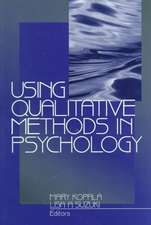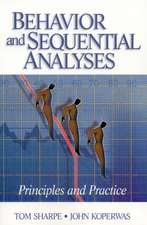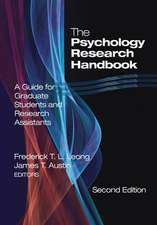Research Methods for Cognitive Neuroscience
Autor Aaron Newmanen Limba Engleză Paperback – 7 apr 2019
With a conversational, student-friendly writing style, Aaron Newman introduces the key principles of neuroimaging techniques, the relevant theory and the recent changes in the field.
| Toate formatele și edițiile | Preț | Express |
|---|---|---|
| Paperback (1) | 462.23 lei 3-5 săpt. | +59.05 lei 6-10 zile |
| SAGE Publications – 7 apr 2019 | 462.23 lei 3-5 săpt. | +59.05 lei 6-10 zile |
| Hardback (1) | 1031.72 lei 6-8 săpt. | |
| SAGE Publications – 8 apr 2019 | 1031.72 lei 6-8 săpt. |
Preț: 462.23 lei
Nou
Puncte Express: 693
Preț estimativ în valută:
88.45€ • 96.38$ • 74.53£
88.45€ • 96.38$ • 74.53£
Carte disponibilă
Livrare economică 02-16 aprilie
Livrare express 18-22 martie pentru 69.04 lei
Preluare comenzi: 021 569.72.76
Specificații
ISBN-13: 9781446296509
ISBN-10: 1446296504
Pagini: 640
Dimensiuni: 184 x 246 x 28 mm
Greutate: 1.23 kg
Ediția:1
Editura: SAGE Publications
Colecția Sage Publications Ltd
Locul publicării:London, United Kingdom
ISBN-10: 1446296504
Pagini: 640
Dimensiuni: 184 x 246 x 28 mm
Greutate: 1.23 kg
Ediția:1
Editura: SAGE Publications
Colecția Sage Publications Ltd
Locul publicării:London, United Kingdom
Recenzii
An excellent and much-needed textbook on research methods for cognitive neuroscience, for the breadth and depth of the techniques, covered. Written in a clear, approachable style, that is easy for even beginning students to digest. This is a book of value that students and professors alike will enjoy reading.
This well-written textbook by Aaron Newman enriches the literature by covering key concepts in research methods for cognitive neuroscience. The book follows a logical progression and covers the main neuroimaging techniques, thus constituting an excellent resource for anyone interested in cognitive neuroscience research and practice. The layout and organisation of each chapter are excellent, there are plenty of visually appealing images throughout and an excellent summary at the end of each chapter.
The book is a fast-track to fundamental knowledge on the general theory of doing research in cognitive neuroscience and a comprehensive introduction to a large panorama of research methods. It gives the reader a strong focus on learning and understanding, and an inspiration to think further into the use of high-tech and basic research instruments. The book is therefore recommended for both the introduction and intermediate teaching into cognitive neuroscience and neuropsychology and in addition as a quick reference work for the single technical methods. A must have for students and teachers in the field!
Aaron Newman's book provides a comprehensive and in-depth, yet easy to read, tour de force across different research methods for Cognitive Neuroscience. This book is not only an indispensable tool for undergraduate students. It is also a valuable source for any neuroscientist, offering an excellent overview of quantitative methodologies in the field.
Overall, this is an outstanding textbook for several reasons.
First, the author has an elegant and yet simple writing. Second, the comprehensive scope of this textbook is simply amazing, such is the complexity of each of the research techniques in focus (i.e., it is extremely difficult to handle all those with expertise). Third, the book structure presents a logic increment in complexity. Aaron Newman integrates seemingly “hard to grasp” computations in a concise style, while providing unique suggestions on experimental design features and data acquisition and analysis. Such methodological concerns tapping the reader’s hands-on-skills are highly meritorious and should appeal to most researchers in the field.
Finally, the textbook layout is impeccable. The “box inlets” at the beginning of each chapter (learning objectives) are quite useful since they help the reader throughout the chapter, eventually pinpointing contents that may merit further study. In addition, the broad summary and “further readings” suggestions at the end of each chapter help to provide awareness of the learning process. A stylish artwork and excellent figures both contribute to top up this edition.
I believe this textbook will soon become an authoritative resource for both graduate students and experienced researchers in the field.
This well-written textbook by Aaron Newman enriches the literature by covering key concepts in research methods for cognitive neuroscience. The book follows a logical progression and covers the main neuroimaging techniques, thus constituting an excellent resource for anyone interested in cognitive neuroscience research and practice. The layout and organisation of each chapter are excellent, there are plenty of visually appealing images throughout and an excellent summary at the end of each chapter.
The book is a fast-track to fundamental knowledge on the general theory of doing research in cognitive neuroscience and a comprehensive introduction to a large panorama of research methods. It gives the reader a strong focus on learning and understanding, and an inspiration to think further into the use of high-tech and basic research instruments. The book is therefore recommended for both the introduction and intermediate teaching into cognitive neuroscience and neuropsychology and in addition as a quick reference work for the single technical methods. A must have for students and teachers in the field!
Aaron Newman's book provides a comprehensive and in-depth, yet easy to read, tour de force across different research methods for Cognitive Neuroscience. This book is not only an indispensable tool for undergraduate students. It is also a valuable source for any neuroscientist, offering an excellent overview of quantitative methodologies in the field.
Overall, this is an outstanding textbook for several reasons.
First, the author has an elegant and yet simple writing. Second, the comprehensive scope of this textbook is simply amazing, such is the complexity of each of the research techniques in focus (i.e., it is extremely difficult to handle all those with expertise). Third, the book structure presents a logic increment in complexity. Aaron Newman integrates seemingly “hard to grasp” computations in a concise style, while providing unique suggestions on experimental design features and data acquisition and analysis. Such methodological concerns tapping the reader’s hands-on-skills are highly meritorious and should appeal to most researchers in the field.
Finally, the textbook layout is impeccable. The “box inlets” at the beginning of each chapter (learning objectives) are quite useful since they help the reader throughout the chapter, eventually pinpointing contents that may merit further study. In addition, the broad summary and “further readings” suggestions at the end of each chapter help to provide awareness of the learning process. A stylish artwork and excellent figures both contribute to top up this edition.
I believe this textbook will soon become an authoritative resource for both graduate students and experienced researchers in the field.
Cuprins
Introduction
Research Methods and Experimental Design
Electroencephalography (EEG) and Event-Related Potentials (ERP) 1
Electroencephalography (EEG) and Event-Related Potentials (ERP) 2
Magnetoencephalography (MEG)
Magnetic Resonance Imaging (MRI) – Basics
Functional MRI (fMRI) 1
Functional MRI (fMRI) 2 - Experimental design
Structural MRI
Connectomics: Diffusion Tensor MRI and Tractography
Positron Emission Tomography (PET)
Near-Infrared Optical Imaging (fNIRI)
Transcranial Magnetic Stimulation (TMS)
Transcranial Electrical Stimulation (TES, tDCS, tACS, tRCS)
Research Methods and Experimental Design
Electroencephalography (EEG) and Event-Related Potentials (ERP) 1
Electroencephalography (EEG) and Event-Related Potentials (ERP) 2
Magnetoencephalography (MEG)
Magnetic Resonance Imaging (MRI) – Basics
Functional MRI (fMRI) 1
Functional MRI (fMRI) 2 - Experimental design
Structural MRI
Connectomics: Diffusion Tensor MRI and Tractography
Positron Emission Tomography (PET)
Near-Infrared Optical Imaging (fNIRI)
Transcranial Magnetic Stimulation (TMS)
Transcranial Electrical Stimulation (TES, tDCS, tACS, tRCS)
Descriere
This book provides a comprehensive introduction to the various methods, techniques and imaging models for measuring the activities of the brain, from fMRI to PET and much more.

















